Deluxe Printing Techniques--Gauffrage
The Joy of Collecting--Pleasant Surprises
Experienced collectors of Japanese woodblock prints are typically well aware of several of the "deluxe printing techniques" that are often encountered in print collecting. One of these deluxe techniques is, of course, "gauffrage" (or embossing). However, perhaps totally unknown to the "less experienced" collector, the resulting "first encounter" with this technique can be quite an unexpectedly pleasant experience. And even as experienced collectors, little we have found can be more exciting than to at times receive a new print "in-hand," THEN to discover upon closer inspection that to our amazement that it is deeply embossed. Discovering "gauffrage" unexpectedly is always a very welcome surprise.
What is "Gauffrage?"
The printing technique that we commonly refer to as "gauffrage" is most easily described simply as "embossing." It also goes by the names of "blind printing, "goffer," or in Japanese, "karazuri," which means literally "empty printing." The Japanese name is actually very apropos, since it describes the printing process in literal terms, that is, done without ink, or "empty." But more on "how it's done" later. For the time being, suffice it to say that "gauffrage" gives to prints something that we today have come NOT to expect from a flat, printed sheet of paper--namely three-dimensionality or depth!!
How to Best View Gauffrage
Depending on the lighting used, the effect of gauffrage can at times often become nearly "invisible" and therefore unrecognized or unappreciated. This problem lies in the "way" in which we are today accustomed to viewing books, artwork, and typically our world in general. Extensive and widespread use of harsh direct lighting is how we've been taught to view our world; but such lighting nearly obliterates all visual evidence of gauffrage's depth and dimensionality. It simply disappears.
To properly view a Japanese print, instead, what is needed is a SINGLE light source. This "directional" single light source will then cast the shadows that are needed to truly SEE and appreciate the beauty of an embossed print. Furthermore, the print should properly be held in one's hands and then even rotated or tipped until the maximum effect can be realized. Indeed, the visual delight can then be quite stunning. And, what was moments before seen only as pigments on a flat piece of paper suddenly becomes alive.
A Bit of History
To research this article, we went both to the many references we have at hand as well as to the "net" and other sources, but surprisingly very little was found. In our own collections, we readily found prints dating to Japan's mid-Meiji period (running 1868-1912), but this simply lead us to wonder further "how old" this technique really was. To help answer that question, we turned to John Fiorillo, an independent researcher, who is a self-taught "expert" in Japanese prints and has written extensively on the subject. Here's what John was able to tell us:
"Gauffrage is a very old technique. There are manuscript albums of poems from the famous anthology "Kokinshu" (Collection of Ancient and Modern Times) dated to the year 1120 that includes a few designs printed with this technique. Another album from the same century has a page with a "wave pattern" printed with "karazuri." (This information John tells us comes from the "Nihon Hanga Bijutsu Zenshu" ("Complete Collection on the Art of Japanese Block Printing), vol. 1, 1961, plates #298-99 (cited in Waterhouse, D: "Harunobu and His Age." London, 1964, p. 9) In my experience examples such as these would indicate the technique was introduced even earlier and gradually perfected (over) time."
John further recalled that in prior discussions he has had with modern day Tokyo printmaker David Bull (who makes his livelihood producing beautiful woodblock prints), that David had indicated that "the actual technique of "karazuri" was really no more difficult than many other printing techniques. In other words, it really doesn't require extra effort from the carver, as he would normally carve a pattern to be inked if he didn't (otherwise) carve one for "blind-printing." The same holds true for the printer, who would generally exert equivalent pressure whether he was printing with inked or UN-inked blocks." This information was all very helpful, which then led us next to our good friend in Tokyo, David Bull.
The Practitioner's Point of View--"How" it's Done
How better then to learn more about the technique of "karazuri" (gauffrage) than to pick the brains of a modern day practitioner who has become a world recognized expert in the art of both carving AND printing Japanese woodblock prints. David's story is really amazing when you learn more about what he is doing and accomplishing, but suffice it to say, after 10-plus years of nearly daily efforts as a printmaker, well, he's become unquestionably the world English-speaking expert in this area.
What follows then just below is what David was able to tell us in a "Q and A format." But first, let us start by SHOWING you one of Dave's prints, a beautiful "surimono" print titled "Spring Fuji" that he produced in 2000. Oftentimes, as you can see, the artwork itself "speaks" louder than words--it's a truly impressive print.
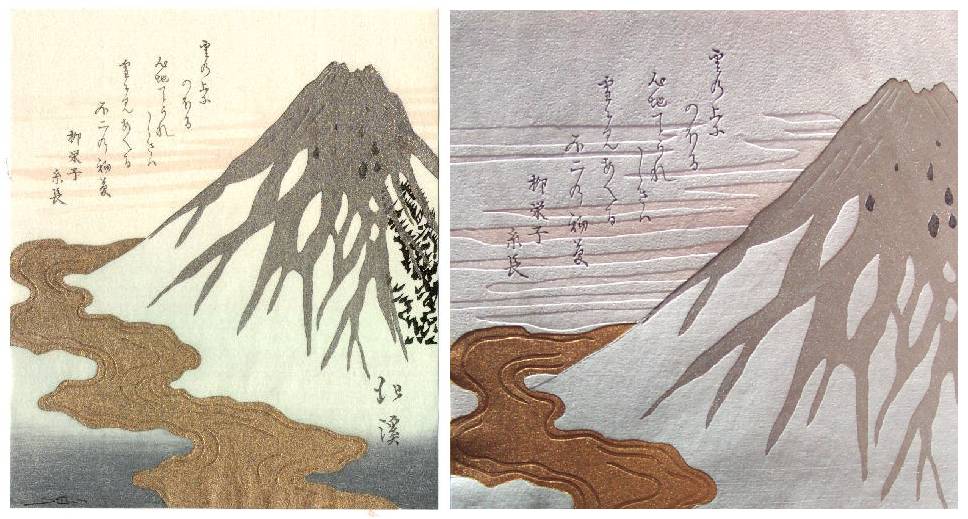
Surimono print titled "Spring Fuji" 2000; by David Bull (1951-present)
Q: OK Dave, tell us exactly how this technique of "karazuri" is achieved. Can you tell us from an actual printer's point of view how it's done?
A: Karazuri is done in exactly the same way as 'normal' printing - by rubbing the paper with a 'baren' onto a carved woodblock. The difference is that for karazuri, no pigment is applied to the block first, so the resulting lines appear as a purely embossed area. The back side of the paper remains flat, and the embossed effect is apparent only from the front of the print.
Q: Is "karazui" done with the paper moist or is it dry?
A: Normal "karazuri" is done with the paper MOIST; it is no different in approach than any other kind of printing, except for the lack of pigment. I can't swear that it was never done on dry paper, but the block would have to be carved specifically for this purpose (if so), as the paper shrinks considerably when dried.
Q: So, is the pressure required the same as when printing with inks, or is harder pressure required?
A: No difference. However, if the paper is thick, and a good deep "karazuri" is wanted, the pressure can be quite considerable.
Q: What would happen if a "gauffraged" print is later immersed into water--for example, if one were wanting to soak it loose from an old backing? Would the "karazuri" be softened, lessened or damaged?
A: Yes, I'm afraid so--although with care the damage would not be too extensive. I've tested this process specifically to find the answer. If you are careful and don't totally soak the print, but instead just moisten it, the damage is minimized; but you will inevitably lose the nice sharp "edge" of the embossed effect. The "karazuri" will never disappear completely though. I've got some backed prints here which I would love to soak off, but am unwilling to lose the fresh "karazuri."
Thanks Dave, it's really good to get the viewpoint, perspective, and first hand experience of someone such as yourself. We appreciate your expertise. (For those wanting to learn more about the printing process from the one guy that we believe knows more about "how to do it" than anyone else, please access Dave's website "linked" at the conclusion of this article.)
The Hidden Beauty of "Gauffrage"
Finally, what follows below are a series of prints that we've gathered from our collections and then attempted to digitally photograph in the "best possible light" to highlight and accentuate this superb printing technique. It can be a "difficult" technique to properly capture as a "photograph" due to the unusual lighting that is required--so some of the "close-ups" might appear a bit "darker" than you would otherwise expect. However, what we've attempted to demonstrate in the "paired pictures" that follow is how typical harsh FRONTAL lighting nearly obliterates all visual presence of embossing, while at the same time, if one simply uses the SINGLE light source as suggested (and holds the print "just right"), these prints then take on a whole new perspective.
OK--let's stop talking about it. Let's instead simply look at some prints!!
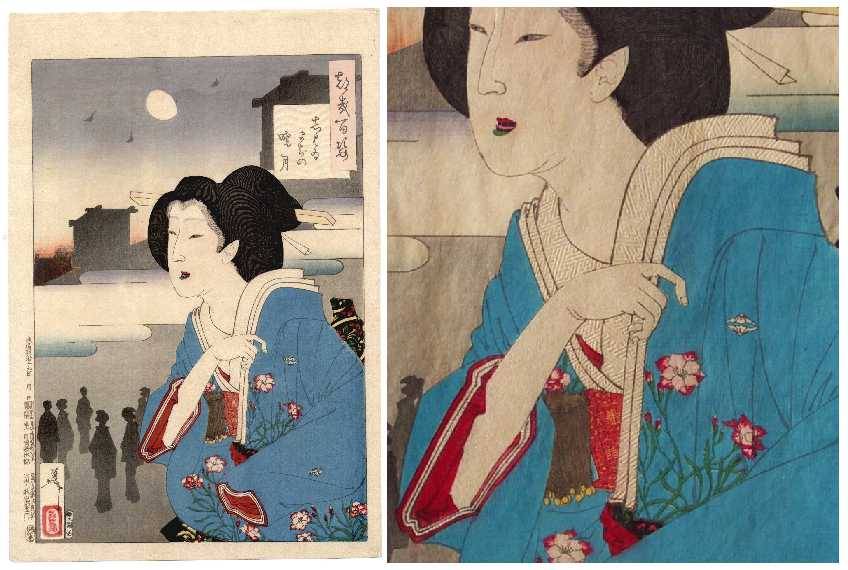
"Theater District Dawn Moon," 1886; TSUKIOKA, Yoshitoshi (1839-92)--Typically Meiji use of "embossed collars."
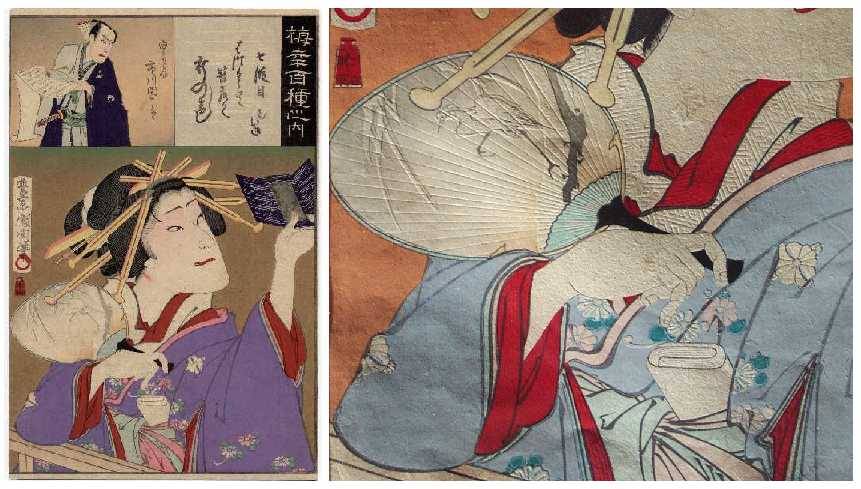
"Plums--Comparisons of Actors: Eiki" 1893; TOYOHARA, Kunichika (1835-1900)--More "embossed collars" and "ribbed" fan.
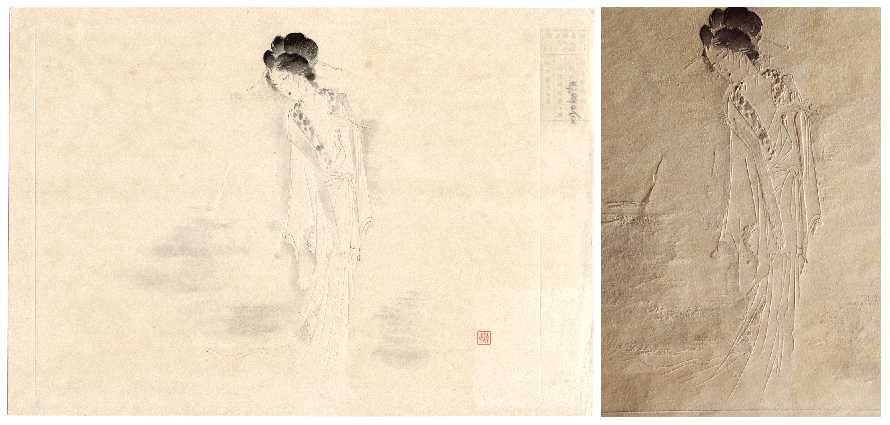
"Ghost" c1920; KABURAGI, Kiyokata (1878-1973)--A beautifully "effective" lack of inks: After all, it IS a "ghost."
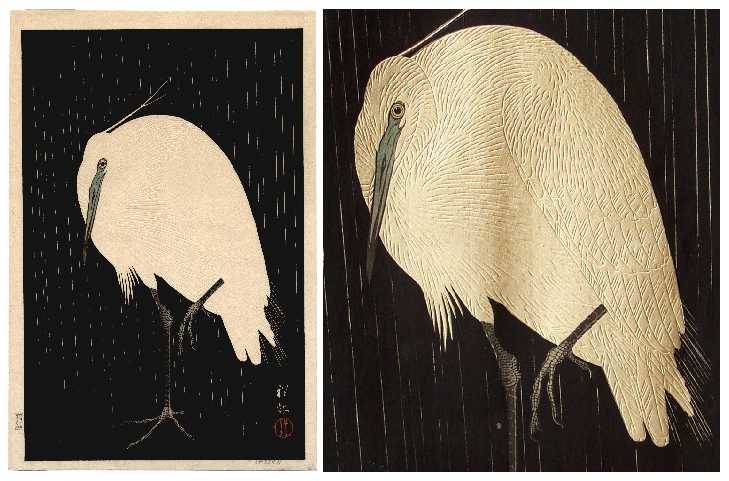
"Egret in Rain" 1928; OHARA, Shoson (Koson) (1877-1945)--Every feather is embossed. Impressive.
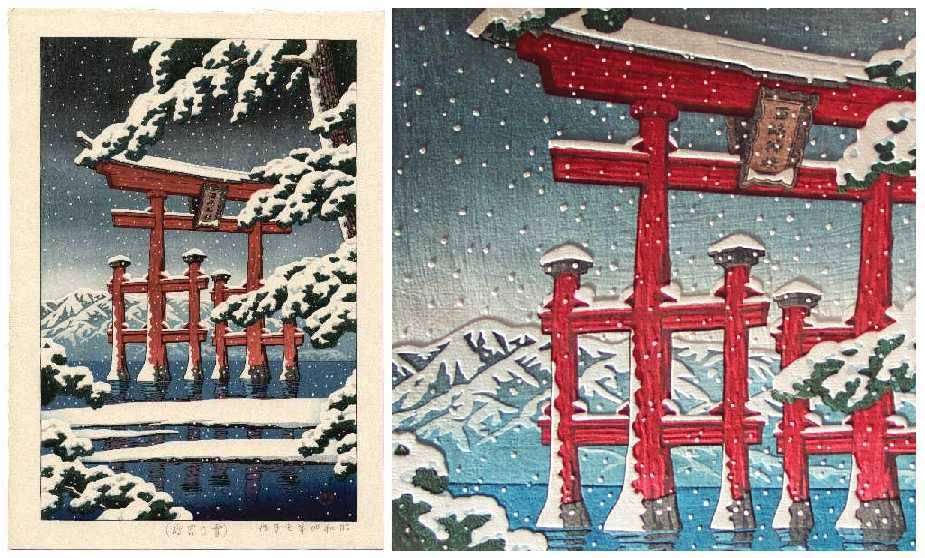
"Snow at Miyajima" 1929; KAWASE, Hasui (1883-1957)--Appropriate use again; "raised" mountain tops and "accumulated" snowfall.
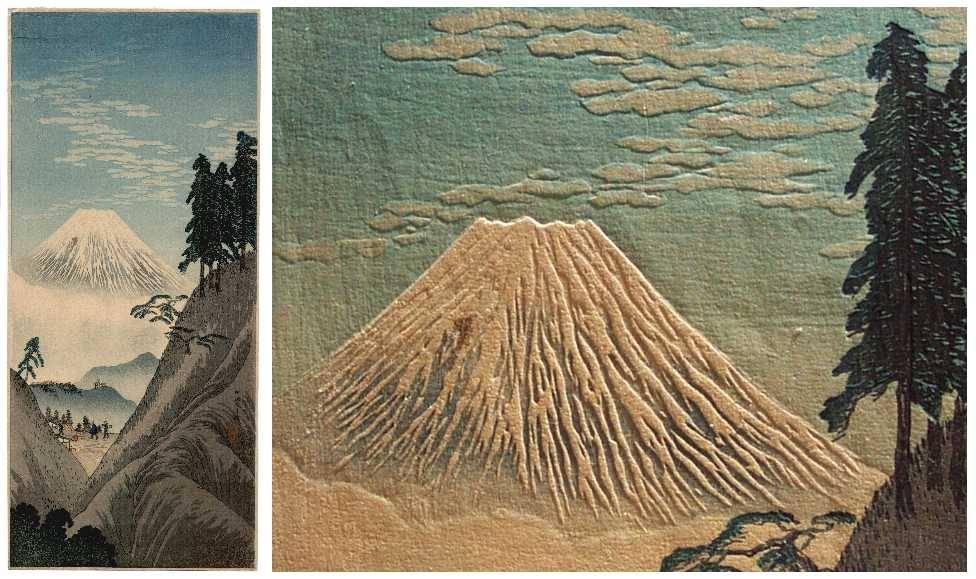
"(Fuji from) Inume Pass" early 1930's; TAKAHASHI, Hiroaki (Shotei) (1871-1945)--Impressive--Mt. Fuji and "puffy" clouds.
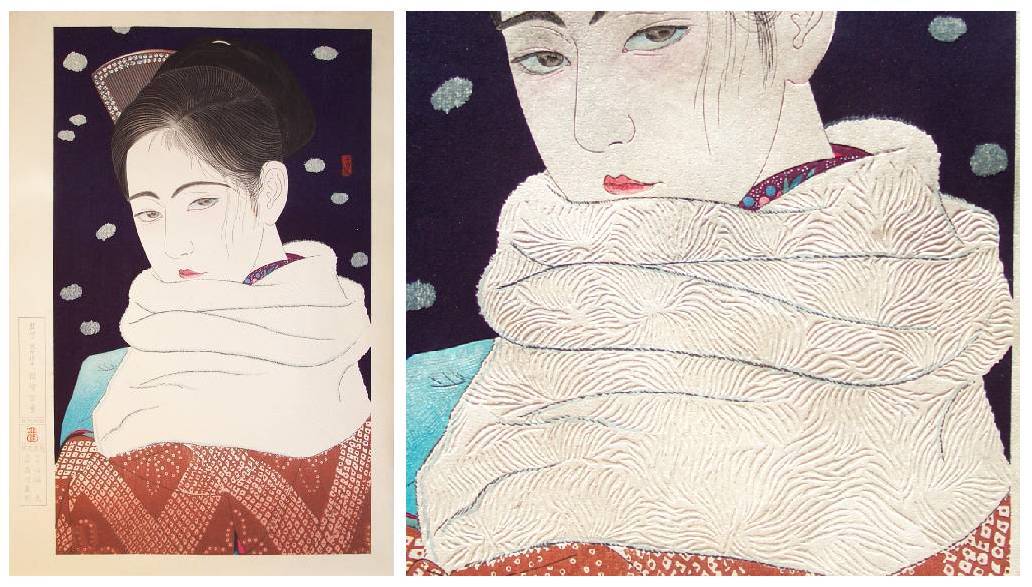
"Expression of Eyes, Hitomi" 1931; KOBAYAKAWA, Kiyoshi (1889-1948)--White shawl--extensively and deeply embossed. Impressive.
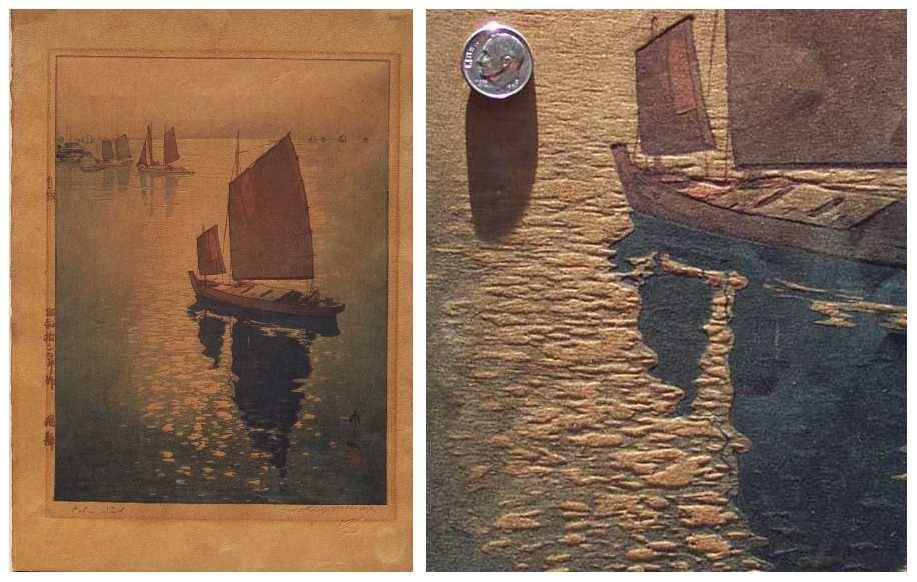
"Calm Wind" 1937; YOSHIDA, Hiroshi (1876-1950)--Waves ARE three-dimensional, don't you think?
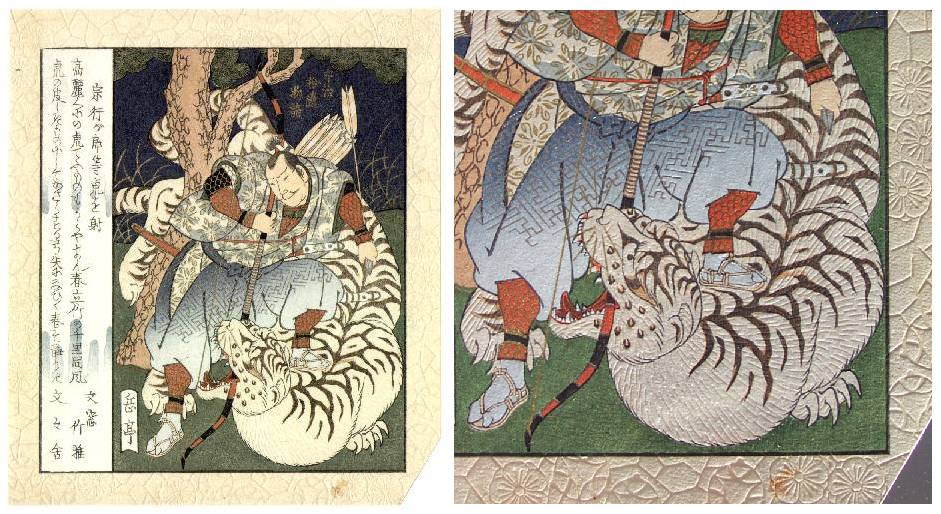
"Warrior and Tiger" 2000; BULL, David (1951-present)--Finally, we end with another Bull "surimono." Appropriate.
Concluding Remarks
We hope that you've enjoyed this article about one of Japanese woodblock printmaking's most beautiful techniques, that of "gauffrage." We also hope at the same time that you've also learned more about "how" to better enjoy your individual prints and your entire collection.
Don't keep your prints tucked away all the time in some dark drawer. At the same time, we've also showed you why it's best not to view them under a harsh, direct light source. Instead--turn off all the lights but one. Then sit down in your favorite chair in this now largely darkened room, sit back and enjoy your prints intimately on a first hand basis. Don't simply put them "on the wall," but rather view them "handheld" as they were intended.
Enjoy your prints!!
We wish to again thank both John Fiorillo and David Bull for their invaluable contributions toward the research of this article. John's website can be accessed directly at "Viewing Japanese Prints;" while David's website can be found at "David Bull's World of Woodblock Printmaking.")
(c) Thomas Crossland and Andreas Grund, 2002
Gallery
Terms
Ordering
About Us
We Buy Prints
Library










